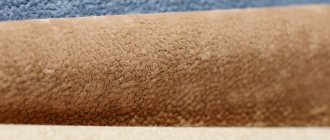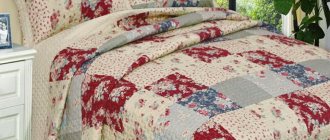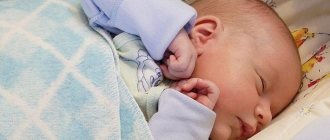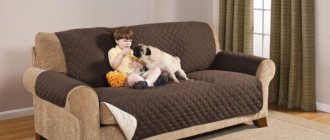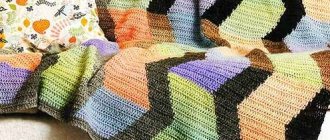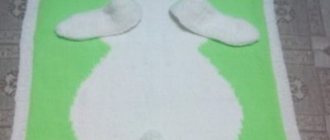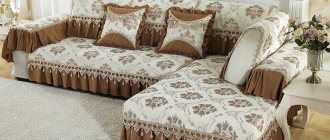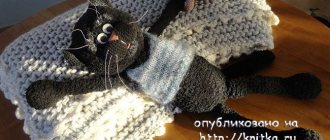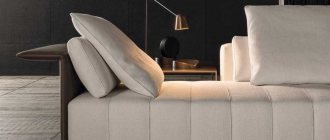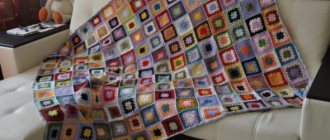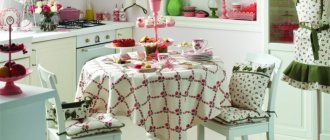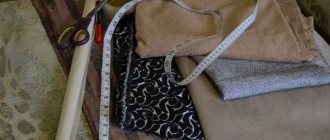Not every needlewoman can knit a blanket The main thing is to be patient and choose the right yarn. Knitting blankets with knitting needles from inexpensive threads is a thankless task. After all, if you use a blanket for its intended purpose, it will quickly lose its appearance and may roll up or fade during the first wash. Therefore, we advise you to approach the choice of threads very carefully.
Some people find it easier to knit a blanket from individual motifs, because... in this case, you can knit on the way to work, at home, at a party, on the train, anywhere. If you knit a whole blanket (and we are now talking about large-sized blankets), then it is problematic to carry it with you while knitting. But if the blanket consists of individual motifs, then the thread has to be torn off, and in the end you will have painstaking work assembling the blanket. So in both cases of knitting a blanket, there are pros and cons.
You have selected the appropriate threads, decided on the knitting technique, all that remains is to find a suitable model. We have collected several models of knitted blankets published on our website earlier, works sent by our readers and interesting options found on the Internet. We hope that you can choose good knitting patterns for a blanket.
Knitted blanket, models from our website
Blanket and cushion covers
For a blanket with knitting needles you will need: 2,200 g for a blanket and 300 g for one cover of white yarn (50% wool, 50% acrylic, 125 m/100 g). Straight knitting needles No. 6, hook No. 5, darning needle. Dimensions: blanket 120*160 cm, cover 40*40cm.
interesting selection on knitka.ru Children's Blankets Blankets for newborns and babies
Sheep wool blanket
Blanket size: 166 x 172 cm. You will need: 2000 g of natural white yarn (100% merino sheep wool; 125m/50g); circular knitting needles No. 3.5, length 120 cm.
Plaid knitted from squares
Blanket size: 112×168 cm, 1 square 28×28 cm. To knit a blanket you will need: 200 g each of blue, purple, yellow-green yarn, 150 g each of golden and green yarn (55% wool, 45% polyacrylic, length. 125 m/50 g), 200 g denim and 150 g oil color (100% wool, length 125 m/50 g). Knitting needles No. 3.5.
Embossed plaid made of squares
Tatiana's work. Nako Atlantic thread 100 g/245 m. Each color took almost 2 skeins, that is, 600 g. The size turned out to be approximately 95 x 115 cm.
Variations on the theme of the “Cats and mice” blanket.
Anna's work. The blanket is knitted with knitting needles No. 2.5; yarn p/w 100g=380m. For size 1.5*2.0, you need to knit 28 squares. One square consists of 72 loops.
Cats and mice plaid. Designed by Gitta Schrade, published in Family Circle Easy Knitting magazine, Winter 2001 “Double knitting” technique, Wool yarn, YarnArt, Turkey, 2.5 mm knitting needles, consumption 1800 g, dimensions 155x175cm.
Knitted blanket. Interesting models from the Internet
Plaid knitted “zig-zag”
The blanket is knitted gradually; individual parts do not require stitching. As a result, you get a double-sided canvas. Each strip can be knitted from a different yarn, allowing you to use up leftover yarn
Chocolate blanket
Using this pattern you can knit a rug, blanket or blanket.
Chic plaid knitted
This incredibly cozy blanket can decorate your home.
Blanket SAMPLER AFGHAN by Melissa Leapman
Melissa's famous blanket - that's how it was dubbed in the knitting world. This model of a blanket with Celtic knots and weaves will require a lot of work, attention and diligence, but the result will delight you and everyone around you for a very, very long time.
Warm blanket made from leftover threads
This blanket can be knitted or crocheted. You need to crochet the squares with single crochets and embroider them according to the patterns. And it will warm you on cold winter evenings for many years.
Knitted blanket
Size: 65 x 165 cm. You will need: 8 skeins of Zealana Kiwi Lace Weight yarn (40% merino wool, 30% cotton, 30% possum wool, 199m/40g); circular knitting needles No. 3.5; 2 auxiliary knitting needles; 6 markers. Knitting density, sequence of patterns: 27 sts and 30 r. = 10 x 10 cm.
Blanket and pillow for the bedroom
For a single bedspread you will need 2900g of cotton thread, and for a double bedspread - 3600g.
Blanket with crescent-shaped motifs
Blanket knitting size: 233.5*152.5 cm. Blanket from Vogue magazine.
Knitted blanket with embossed leaves and twig motif
Size: approximately 183 by 223.5 cm.
How to knit a blanket with knitting needles pattern “Braids”
This pattern has its advantages:
- This is not a complicated scheme that even a beginner can do.
- The pattern is voluminous, so it looks good on a large bedspread.
- The bedspread is durable and serves its owner for a long time.
Technique:
- in order to make braids, you need to do four rows of work, then we do the weave and knit four more rows. We do the weaving again;
- then we perform six knit and six purl loops to create a distance between the braids.
The work turns out to be simple, but the drawing itself looks gorgeous, thanks to the volume of the pattern. You can take several colors of thread to get multi-colored braids.
Features and Benefits
A knitted blanket on the bed looks homely and at the same time stylish. You can choose products made in different ways, connected with interesting patterns and styles. Such bedspreads have many advantages:
- Knitted home textiles are perfect for a children's room, bedroom, living room.
- Easy care. Knitted bedspreads are perfectly resistant to machine washing at a temperature of 30-40 °C.
- The ability to independently make a product of any size, color.
- A wide range of yarns of various colors, many patterns for making bedspreads allows you to get an exclusive blanket.
- During the knitting process, every stage is controlled, from the selection of yarn to the choice of the pattern of the future blanket. You don’t have to choose between the appropriate size, color and design of ready-made products.
- Affordable price. Ready-made handmade blankets will not be cheap, however, you can save a lot by making home textiles with your own hands.
In cases where it is not possible to knit a bedspread yourself, you can order the product in a special store or from craftswomen, having previously discussed all the nuances.
Bedspread with beautiful weaves - description and diagrams
Size: 95cm by 210cm.
We will need:
- yarn containing 75% acrylic, 20% mohair, 5% alpaca (50g per 70m) – 1300g;
- knitting needles No. 6.5.
Patterns:
- persons smooth surface: in knits. in rows with knit stitches, purlwise. R. - purl;
- garter stitch - all sts in all r. facial;
- pattern “Rice”: 1p.: 1l.; 1i.; 2p.: above the faces. knit purl, over purl. – facial stitches;
- pattern “Fantasy elastic band” according to the diagram;
- “Braids - plaits” - see diagram;
- main pattern “Rhombuses” - see diagram.
Density: on the “Rice” pattern 12p. for 19 rub. equal to 10 cm by 10 cm.
Explanation of symbols:
- cross of 6 p. to the right: remove 3p. on aux. sp. at work, 3l., 3p. with aux. sp. facial;
- cross of 6 p. to the left: remove 3p. on aux. sp. before work, 3l., 3p. with aux. sp. facial;
- cross from 3p. to the right through 1p.: remove 1p. on aux. sp. at work, 3l., 1p. with aux. sp. purl;
- cross from 3p. to the left through 1p.: remove 3p. on aux. sp. before work, 1i., 3l. with auxiliary sp.;
- cross from 3p. to the right after 1 p.: remove 1 p. on aux. sp. at work, 3l., 1p. with aux. sp. persons.;
- cross from 3p. to the left after 1 p.: remove 3 p. on aux. sp. before work, 1l., 3l. with auxiliary sp.;
- cross from 1p. to the left after 2 p.: remove 1 p. on aux. sp. before work, 2l., 1l. with auxiliary sp.
How to knit a blanket - detailed description
We cast on with knitting needles 140 sts. and knit: 8p. – “Rice”, 5p. – fantasy cutting, 3p. – “Braids”, 5p. – fantasy cutting, 26p. – “Rhombuses”, 5p. - phantom cut, 3p. – “Braids”, 5p. – fantasy cutting, 20p. – “Rice”, 5p. - phantom cut, 3p. – “Braids”, 5p. – fantasy. cutting, 26p. – “Rhombuses”, 5p. - phantom cut, 3p. – “Braids”, 5p. - phantom cutting, 8p. - "Rice".
Having knitted the blanket 23 cm (= 44 r.), on the sections of the “Rice” pattern we begin to perform * 2 r. persons satin stitch, then - 6p. shawl rice, 2p. persons ch., then return to the knot. “Rice” and knit 50 rubles* - from * to * repeat with knitting needles to the desired height until the part is full size.
Having completed 398r. (=210cm) and knitting the 12th r. “Rombov”, we finish the work by closing all points.
Varieties
A knitted bedspread for a bed in the bedroom can be made using various methods, each of which has its own characteristics:
- Machine knitting. If needlework does not attract the housewife, you can purchase a finished product in a store. In addition, it is possible to buy machine-knitted knitted fabric. As a rule, the roll has a standard length and after the required footage is cut, all that remains is to process the edges. This can be done using an overlocker or bias satin binding. Processing with light silk and contrasting fabric will look beautiful.
- Hand knitting. It is the most affordable method of making a fashion accessory for the interior. Even the simplest technique will allow you to get a very nice product. If you choose large knitting needles and thick threads, it will take a little time to make a blanket. The main thing is to remember that the simpler the pattern, the neater the bedspread will be. During the knitting process, you need to try to ensure that the loops are the same size and do not stand out from the general row.
- Crochet. With this tool it is easier to make a small-sized blanket, because this technique requires a large number of loops, and it is much more difficult to maintain the shape. You can use a technique in which parts are connected using additional columns into a single web. A crocheted bedspread is perfect for a country or Provence style bedroom. Such products are often not able to fulfill the function of a blanket in which you can wrap yourself on a cool autumn evening, since they turn out to be openwork and light. However, in appearance they are very reminiscent of lace and decorate the interior.
When choosing a pattern, you need to understand that each of them is made with different threads. The dimensions of the bedspread depend on their thickness, so you can take the pattern of the tablecloth as a basis, but use thick wool as the material rather than cotton yarn.
Colors and sizes
The dimensions always depend on the area of the sofa or bed on which the blanket will be placed.
And the colors can be very diverse. The main thing is that the color of the blanket does not stand out from the overall style of the room.
You also need to take into account the “practicality” of the chosen color and the frequency of use of the product. If the product will be used frequently, then it is better to look towards black, gray, mustard, red, brown, etc.
There are quite a lot of options in which you can create the desired blanket model.
If we are talking about handmade work, then there are 4 ways to make a product:
- In a straight line.
- Circular.
- Diagonal.
- Assembled from individual squares.
Yarn used
The correct choice of material largely determines the final result. The finished product should not cause allergies and be difficult to care for . In addition, the yarn directly affects the complexity of making the bedspread, the appearance and cost of the product. As a rule, for knitting a bedspread the following is used:
- Wool. The most popular material for making a knitted bedspread. The wool used is sheep, goat, merino, alpaca, camel, and rabbit. Products made from this thread have a massage effect, provide warmth, and the bedspread “breathes.” Blankets made from this material require delicate washing using special products. Products made from natural wool are contraindicated for allergy sufferers.
- Cotton thread is suitable for making openwork bedspreads. These products are easy to wash and feel very pleasant to the touch. Threads made from viscose, bamboo and silk have similar properties.
- Synthetic thread obtained using industrial methods is also suitable for making bedspreads. Such products are particularly soft and fluffy. The material has a fairly low cost, but blankets made from such threads do not breathe, become electrified and quickly lose their appearance.
- Blended yarn is an ideal solution in terms of cost and quality ratio. Blankets of this type are more comfortable than synthetic ones, but will not itch like wool blankets.
- Thick yarn. Its main types are: knitted, velor, plush. The last two options contain 100% micropolyester (thread evenly covered with dense, soft and silky pile). Products made from such material are surprisingly delicate and cozy. The color palette of yarn is very diverse, and the knitting process itself brings a lot of pleasure. A blanket made from such a thread will be very soft and fluffy. Products made from knitted yarn have an interesting texture and are surprisingly elastic. The bedspreads are wear-resistant, and the price of the material will please you.
How to decide on the size
The dimensions of the bedspread are selected individually, however, when calculating the dimensions of the future product, you should be guided by generally accepted standards:
- the blanket in the crib must be no less than 110 x 140 cm;
- for a single bed, a product 140 x 200 cm is perfect, in some cases its length can be increased by 20 cm;
- for a lorry choose bedspreads 150 x 200 cm and 160 x 200 cm;
- for a double bed, products measuring 180 x 200 cm and 200 x 220 cm are suitable;
- Euro bedspreads have large dimensions: 220 x 240 cm, 230 x 250 cm, 270 x 270 cm.
To determine the appropriate size of blanket, you need to measure the width of the bed, and then add about 20-25 cm to it . Ideally, the cover should cover the mattress, but not hang down to the floor. The length of the product is selected based on the presence of a leg back and is 200 cm if it is present, or 220 cm if it is absent.
In cases where the bedspread serves a purely decorative function, its dimensions can be much smaller, for example 80 x 100 cm, 100 x 100 cm, 110 x 110 cm.
DIY making
Before making a bedspread with your own hands, you need to prepare everything that is required during the knitting process:
- yarn, the amount of which depends on the size of the product, the thickness of the thread and the chosen pattern;
- knitting needles or crochet hook.
The knitting pattern depends on the chosen tool. When choosing a pattern, you should consider the following recommendations:
- if the product is intended to decorate the foot of the bed, then it is better to prefer braids, which will give a feeling of warmth and comfort;
- for a nursery, you should choose a simple ornament or a completely smooth surface;
- a thin openwork bedspread is suitable for a girl’s bedroom or a newborn’s crib;
- a blanket made of squares of different colors will decorate a country-style interior or a sofa in the country;
- If the walls in the room are made in a rough style, then a blanket made of thick yarn will help soften them.
In cases where the room is very small, it is better not to choose a product made from bulky thick yarn - it will take up a lot of space. It is worth giving preference to a model made of wool thread.
Handmade bedspread “Honeycombs” - an interesting and unusual solution for a sleeping bag or living room
Knitted items in the interior are now very popular and in great demand. They are very versatile: the use of different materials, colors and structures makes such interior details suitable for any style.
The blanket is crocheted from individual motifs in patchwork style, dense and soft to the touch, and will serve as a wonderful addition to your interior.
Crocheted bedspreads are one of these products. The interior design industry offers a huge selection of crocheted blankets, but you can knit them yourself.
Openwork blankets
For lovers of exclusive decorative elements, there is a method of knitting blankets from motifs, which in the course of work are connected to each other and create unique openwork patterns.
Often, floral motifs are used for such bedspreads. These blankets will perfectly decorate your bedroom or living room.
Advantages of a hand-knitted bedspread
A plaid with a three-dimensional pattern is obtained through skillful combinations of colors that create the effect of three-dimensional cubes located in space
Do-it-yourself knitted bedspreads have a number of advantages:
- Coziness. A blanket knitted with your own hands will warm you much better than a store-bought one and will create an incredible spiritual atmosphere.
Soft and airy, light and openwork bedspread “Star Miracle”
An exclusive knitted mandala blanket with a round shape will create an atmosphere of comfort and warmth in your home.
Blanket with hearts in disco style made from yarn of the brightest colors
- Saving. Crocheting a blanket with your own hands is cheaper than buying it.
Textured styles such as boho, Provence or country will perfectly accept a patchwork style bedspread with original floral motifs and fringe.
For modern modernism or minimalism, a bedspread of restrained colors and not too pronounced texture is suitable
Design selection
A bright blanket made from the most beautiful shades of yarn with a wave pattern will create a sunny, rainbow mood
If you decide to crochet a blanket, you need to decide on its design. When choosing a bedspread design, you need to pay attention to the following points.
- Product functionality – why do you need a blanket? If you use it only as a decorative element, then you can choose any openwork volumetric patterns (you are limited only by your crochet skills) and synthetic, knitted yarn. Also use ribbons and beads. For a blanket that needs to provide warmth, wool or plain yarn using simpler, tighter knitting patterns is suitable. For a blanket that combines these two qualities, it is necessary to find a compromise: if it is synthetic, then only dense knitting; if it has openwork patterns, then with fewer holes, using wool or simple yarn. Bedspreads intended for sitting should not have bulky knitting or beads. And for products that protect furniture from contamination, it is better not to use openwork patterns.
A bright children's blanket made from denim yarn will warm a baby in a stroller or crib and will become a decoration in the nursery.
An elegant blanket with a geometric pattern made of natural threads in snow-white, azure, blue, pink, red, and wine colors
Crocheted openwork blanket made of square motifs
The blanket, crocheted from white yarn, is designed in a natural theme and has a pattern - stylized trees
The most versatile and easiest to make is a crocheted bedspread, consisting of squares of the same size and connected to each other. Even a novice needlewoman can easily handle such a product.
A bright crocheted blanket made of colored square motifs will effectively complement any interior and become a favorite and integral element of it.
By the way, if necessary, a hand-made blanket can easily be enlarged or reduced by adding or removing a certain number of squares, respectively.
Bedspread for a single bed in warm colors - from white to dark brown
Necessary materials:
- knitting threads or special knitting yarn (required). The quantity depends on the size, thread thickness, and chosen pattern;
- ribbons, beads (optional);
- sewing thread (optional, as you can use yarn).
Multi-colored soft yarn of the same thickness
Required tools:
- a hook of the appropriate size (depending on the thickness of the selected material);
- a needle with a large eye (for sewing squares, sewing on decor).
Crochet hook
The process of making a crochet bedspread
- Select a product diagram. It is not necessary that all squares must be connected according to the same pattern - you can choose several, focusing on your desires and fantasies. The Internet is replete with patterns for square knitting. The designations are quite simple, understandable, and understanding them will not be difficult. But for beginning needlewomen, it is better to choose basic patterns, so that the pleasant, peaceful process does not begin to irritate and discourage handicrafts.
Pattern for knitting squares for a bedspread
A plaid of square motifs is crocheted in blue tones
Ready-made plaid crocheted from motifs
Beautiful knitted blankets in the interior
If you still don’t dare to dare to create knitted furniture, we suggest you try your hand at products that are easier to make, but no less impressive.
. It's no secret that exclusive designer items cost a lot of money. Why not decorate your home with one of these handmade ones? Shopping club experts invite you to carefully consider knitted blankets, photos of which are presented in sufficient quantities on the Internet.
At first glance, it seems that creating them will require a lot of time, yarn and patience. The work is indeed not easy, but even a novice knitter can handle it if desired. The most important thing is to choose the right model .
Decoration
Stylish handmade bedspread
To decorate the finished bedspread, use ribbons, threading them through the natural holes between the posts, beads, and pre-knitted flowers with frills.
The blanket will fit perfectly into a modern interior thanks to its simple but appetizing design.
With some thread and a little patience, you can spend time watching your favorite TV series with benefit for the comfort of your home.
Double-sided crocheted blanket, can be used as a blanket on a sofa, wide bed, or as a light blanket
How to knit a baby blanket?
Children's blanket knitted and crocheted is made from high-quality and hypoallergenic yarn. It is important to consider the presence of allergies to wool and, if necessary, replace the composition. The option of cotton products is universal.
It is recommended not to use yarn with fluff and long pile.
Before manufacturing the product, you need to draw up a sketch; in addition to the classic model, you can include images of fairy-tale characters, and add pom-poms, buttons and buttons to the model for transformation. The products are universal and can be used as a carpet for children, an envelope, or a cape.
The list of popular product models includes:
- in the shape of a hare with ears;
- in the form of an owl;
- in the shape of a bear;
- complemented by a hood.
After drawing up a sketch and taking measurements, the volume of yarn is calculated, a knitting technique and a diagram are selected with a description on the specialized website. After completing the work step by step, the loops are closed, the threads are removed and the model is smoothed.
From thick yarn
A DIY chunky knit blanket is suitable for decorating your home and creating an original accent accessory in your interior. The product is woven using knitting needles or by hand.
To weave a blanket without knitting needles, merino yarn is required.
The knitting technique is simple, without openwork inserts. The basic loops are thrown over one hand, then transferred to the other and gradually knitted into fabric. For a product with a width of at least 1 m, you will need to cast on 15 loops. The work is completed in 1-2 hours.
